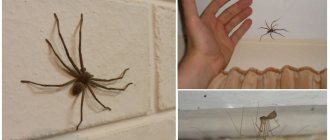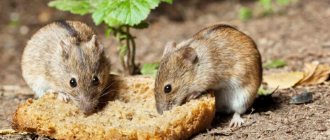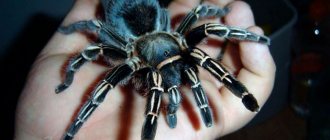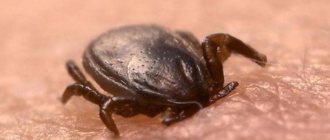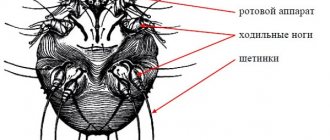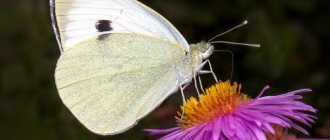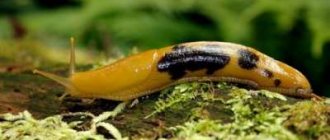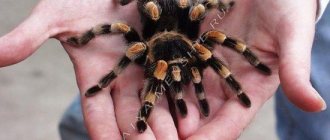An Australian woman posted a video on her Instagram showing her holding a spider with dozens of tiny babies on her back. During the video, they do not stop moving, which horrifies many social network users, who almost drop their phones on the floor out of fear. But this is how a spider takes care of its offspring.
Lisa Van Kool Donovan is an aspiring entomologist, which means she's not afraid of spiders, bugs, or worms. And where does the girl live? Of course in Australia!
wannabe_entomologist
Considering where she lives, it’s not at all surprising that Lisa came across a “fluffy spider.” We already wrote about him when he was, but there was no video there. Now the spider with thousands of small eyes on its back can be seen very closely in the video.
In fact, this is not a spider, but a female spider, and to be very precise, a female of the so-called wolf spider. This arthropod is not as intimidating as its name might suggest. They are called that because they hunt without the help of a web. Moreover, female wolf spiders are one of the few who take such careful care of their offspring, carrying their spiderlings on their backs until they are able to get food on their own.
Lisa herself was very touched by the video with the wolf spider, but not all subscribers share her opinion. If you are among those who are more likely to be frightened by spiders than to awaken tender feelings, it is better for you not to go to a girl’s Instagram account, because there you can find, for example, something like this.
This is her favorite type of insect - predatory bugs. People who were not warned about the content of this video throw their phones on the floor, as they themselves admit in the comments.
Instagram thinks I might like this video. I almost threw my phone on the floor! No, your videos are really cool, but I can't control my fear! Expand
And, of course, Lisa keeps arthropods at home. For example, she raised the spider in the video below from the moment it hatched from the egg, and now treats it like a child.
The nature of reproduction in tarantulas is very complex, and in our time very little studied. Young males and females have similar lifestyles and are almost impossible to distinguish by their behavior.
I distinguish pubescent males from females by the way of life they lead and by their appearance. In most species of tarantula, the males are brightly colored. They are often much smaller in size than females and have proportionately larger elongated paws and a different arrangement of pedipalps, thereby differing from females in greater mobility.
Sexually, males mature earlier than females. On average, males reach sexual vision at 1.5 years, while females reach maturity no earlier than 2 years (in some species the difference is even greater - 1.5 and 3 years). “Closely related” mating of spiders that emerged from the same cocoon remains impossible under natural conditions. But such crossing is still possible when the spiders grew up in captivity, by artificially creating different temperature and moisture conditions for the spiders for a feeding regime from an early age.
Mature male
, weaves what is called a sperm web before mating. This sperm web is shaped like a triangle or quadrangle, into the lower part of which he secretes drops of sperm. The sperm is captured by the copulatory apparatus, after which the male begins his search for a female. At such times, the spider behaves diametrically opposite to constant life. During the mating period, the male wanders, is very active and can be noticed when he moves even in the daytime. Male tarantulas travel approximately 7–9 km in one night alone in search of their female.
The male finds the female
only with the help of its sensation (the spider’s vision does not affect these searches in any way: the male very quickly finds a female with blurred eyes) by the smell of the trace that she leaves on the rock or web near her burrow (for example, a female Aphonopelma hentzi near the entrance to her the hole is woven by a small ball of cobweb).
Finally, having finished his search, the male moves into the hole. Thus, having met a female, there may be 2 variations of this event:
In the first option, if the female is still not ready for mating, then she begins to very quickly attack the male, spreading her chelicerae in order to kill the male. In this situation, the male must retreat, or he has a chance:
1) be a “nourishing” food;
2) to be left without one or a pair or three limbs. Since the female initially does not perceive him as her sexual partner.
2nd option. In this case, the female may often show no interest in her partner. In such cases, the male lowers his cephalothorax and raises his abdomen, stretching out his front paws and pedipalps in front of him, then he begins to back away towards the exit, in this way the male tries to attract the attention of the female (it seems to be inviting her to follow him) . After some time, the spider stops and again moves its front legs in different directions - to the left or to the right. And with all this, he does not forget to raise his body so that the female’s interest in him is not lost until the couple leaves the hole and goes outside. When the male is not outside again, he will not feel confident and will not be able to move around safely.
Male courtship
- tarantulas are much simpler than other types of spiders. Other spiders are characterized by very unusual mating behavior, it consists in performing peculiar so-called “mating dances”, for example in species such as Araneidae, Salticidae, Lycosidae, or the male offers the female recently killed prey (as in Pisauridae).
The male spider begins to slowly approach the female, instantly touching her with the front pair of his limbs and pedipalps, or begins to knock his paws on the substrate. As a rule, the male periodically repeats these actions from time to time to make sure that the female will not harm him in any way. To date, no research has yet been carried out to determine whether there are any behavioral features of other tarantula species during crossing.
If the female is still behaving passively, the male will gradually approach her, moving his front pair of legs between the pedipalps and chelicerae, which she places when she is ready to mate. Then the male seems to press into them with his tibial hooks in order to take a stable position and pushes back the female’s cephalothorax, “stroking” the lower part at the base of the abdomen.
When the female shows her full readiness to mate
(this is also often manifested in the abundant “drumming” sound that she makes with her paws hitting the substrate), the male wraps embolus 1 of the pedipalps and inserts it into the gonopore, which is located in the epigastric groove. The spider repeats the same procedure with the 2nd pedipalp. Strictly speaking, this is the very moment of copulation. All this happens within a couple of seconds. Often, the male quickly crawls away after this process, as the female will follow him.
It is known that the female eats her partner after mating, but this is not at all the case, i.e. often this does not happen (frequent cases when the male eats the female, and not vice versa), if the male has enough space for him to move away, then he can fertilize several more females afterwards. The spider can mate with several males in one season.
The eggs are fertilized
in the uterus, the spermatic receptacles come into contact with it, and after a certain period during copulation (1-8 months), such a long process directly depends on different conditions (seasons, temperature changes, amount of moisture and food), and of course a certain type of tarantula When weaving a cocoon, the female lays her eggs there. All this action takes place in the inhabited chamber of the hole, and then it transforms into a nest. The cocoon is usually made up of 2 parts, which are fastened at the edges. Initially, the main part is woven, then the masonry is laid on it, and then it is woven with the covering part. Certain species (Avicularia spp., Theraphosa blondi) weave their “protective hairs” into the walls of the cocoon to protect it from unwanted enemies.
Unlike other types of spiders, the female tarantula protects and cares for her clutch. Sometimes she turns the cocoon over with the help of her chelicerae and pedipalps. She can also move the cocoon if the temperature begins to fluctuate and the humidity level drops or rises. This is due to certain difficulties in artificially incubating spider eggs at home. There are many cases where a female ate her laid cocoons due to stress or for reasons unknown to science. For this purpose, American, German, English and Australian collectors invented the incubator. Lovers simply take the cocoons from the female, thereby taking on the “mother’s responsibilities”; they twist the cocoons with their own hands, several times a day.
It is curious that for some species of tarantulas the following fact is known:
After successful mating, females lay several cocoons, with some gap in time, as a rule, this is no more than one month:
Hysterocrates spp., Stromatopelma spp., Holothele spp., Psalmopoeus spp., Tapinauchenius spp., Metriopelma spp., Pterinochilus spp., Ephebopus spp. etc. What is most surprising is that the percentage of unfertilized eggs increases noticeably in repeated clutches.
The number of eggs that a female lays certainly differs depending on the species and directly depends on her size, age and other factors. The largest number of eggs is known for the species Lasiodora parahybana and is approximately 2.5 thousand pieces!
In small spiders, the number of eggs does not exceed 30-60 pieces.
Incubation time:
also different - 0.8 - 6 months. It is very interesting that tree species tend to have shorter lines than terrestrial ones.
Average incubation temperature
– 26-28°C, humidity should be 80%, only for such genera of tarantulas as Xenesthis, Megaphobema, the incubation temperature should not exceed 25°C.
Sizes born
to the light of small spiders on average from 2 to 5 mm (for example, Cyclosternum) and up to 1.5 cm in the leg span of the goliath tarantula Theraphosa blondi. Newly born spiders of arboreal species are often larger than those born to terrestrial tarantulas, but the number of babies is usually much smaller (no more than 250). Newly born tarantulas are very mobile, and at the least danger they hide and run to a nearby shelter or very quickly bury themselves in the substrate. This behavior of spiders is typical for all types of spiders (arboreal, burrow, ground).
Young spiders of the same clutch hatch at approximately the same time. Before hatching, tiny spines are formed at the base of the pedipalp of the embryo - “egg teeth”, with the help of which the spider breaks the shell of the egg and is born “into the world”. For the so-called post-embryonic molting, which most often occurs inside the cocoon, the newly born baby has very thin integuments, his appendages are not separated, he still cannot feed himself, therefore he lives off the accumulated yolk, which remains in the intestines. This one of the life stages is called “prelarva” (after which they turn into stage 1 nymphs). After the next molt (3-5 weeks), the prelarva turns into the “larval” stage (2nd stage nymph), also a non-feeding individual, but more or less mobile and already having the smallest claws on the paws and developed chelicerae (Vachon, 1957) .
With subsequent (postembryonic) molt
Young spiders begin to form, which become more active and able to feed themselves, crawl out of the cocoon and for the first time, most often, stay in a heap, and then scatter in all directions and begin to live independently.
Most often, after young spiders emerge from the cocoon, the female no longer worries about them, but a very interesting feature of nature in the genus Hysterocrates from the island of Sao Tome, Pamphobeteus, Pterinochilus. This feature is that after birth, the spiders live next to the female for about six months. With all this, the female shows true, maternal love for her children. This feature was noticed only in this species; in other species this phenomenon has not yet been noticed (but there are some exceptions here). The mother very actively protects her children from any possible danger and obtains food for them herself. Similar facts are known with such a species as Haplopelma schmidti (E. Rybaltovsky).
Nature and lifestyle
The lives of young spiders are most often very similar to the lives of adult spiders. They make their own burrows and hunt a lot to get their own food, which is an acceptable size for them. The number of sheddings varies throughout life. The amount of molt depends on the size of the tarantula and its gender (in males the number is always less than in females), for example, 9 – 15 molts per life. The average lifespan of female tarantula spiders is also very different compared to males.
Arboreal spiders, and even such large spiders as Poecilotheria, as well as tarantulas of the genus Pterinochilus, live no more than 15 years. Large terrestrial, namely American spiders, live in a terrarium from 25 years, and according to some facts, even to an older age (for example, the age of the female Brachypelma emilia, who lived with S.A. Schultz and M.J. Schultz, was approximately 35 years).
The lifespan of males is
significantly less, on average 3-5 years. Due to the fact that males reach sexual maturity much earlier than females (at 1.5-4 years), and, often, the average lifespan of male tarantulas in their last molt (after the appearance of sexual characteristics in males) ranges from 5 months to 1 ,5 years. But for some species samples much longer periods are known (6 years).
According to Dr. Claudio Lipari, the life span of the last instar males of the Brazilian Grammostola pulchra is no less than 2.5 years, and one species lived for about 5 years.
The rest of the long-lived male tarantulas of the last instar, according to Lucian Rosa, are as follows:
Grammostola rosea – 18 months,
Megaphobema velvetosoma - 9 months,
Poecilotheria formosa - 11 months,
Poecilotheria ornata - 13 months,
Poecilotheria rufilata - 17 months.
According to the report of the Canadian scientist Rick West, a sexually mature male tarantula Phormictopus cancerides lived with Allan McKee, although after his moult he lost the upper segments of the pedipalps - 27 months, and the male Brachypelma albopilosum with Rick West himself - 2.5 years after the onset of sexual maturity and died during the next moulting.
We also know about a unique case when amateur Jay Stotsky had a male with a small size of the tree species Poecilotheria regalis very successfully moult 2 times! at the latter age, the intervals between molts were 18 months. But with all this, the pedipalps and one chelicera that he lost during the first molt were completely restored after the second moult!
True, it should be said that such cases became known only when tarantulas were kept in a terrarium.
As for the onset of sexual maturity of tarantula spiders, the following information is usually contradictory.
Males of the genus Aphonopelma reach sexual maturity at 10-13 years, females at 10-12 years. Tarantulas Grammostola burzaquensis become sexually mature at 6 years (Ibarra-Grasso, 1961), Acanthoscurria sternalis - at 4-6 years (Galiano 1984, 1992).
Thank you for your attention!
Everything living comes from an egg. The spider is from there too. The spider embryo, highly segmented (like its distant marine ancestors), lies on the yolk of the egg just under its shell. Then all its segments merge together, and the spider embryo takes on its typical appearance: an abdomen without segments and in front an eight-eyed cephalothorax with chelicerae, pedipalps and eight legs.
When it grows and fills the entire egg, the egg shell bursts or the spider tears it with its so-called egg tooth, which temporarily and specifically for this purpose (as in chickens) grows at the base of each pedipalp in the embryos of some spiders.
A newborn baby spider waits patiently in its broken “shell” for its first moult. It is still helpless, colorless and naked - without hair and bristles (in most species). It cannot weave a web and cannot eat either. But judging by its appearance, this is an almost ready-made spider, and not a larva, as in some insects. True, much of it is still underdeveloped - eyes, chelicerae, poisonous and arachnoid glands. Therefore, newly born spiderlings are called, like young dragonflies, nymphs or even pre-nymphs.
In the first days of its life, the spider feeds on yolk, stored for future use in the abdomen. Soon he sheds his infant “skin”, in which he is already cramped. When it sheds, it grows quickly while its new chitinous shell (already hairy and colored!) is still soft and stretches. And when it hardens, the spider must wait until a new molt grows: its hard skin-skeleton does not expand in length or thickness.
He now knows how to weave a web, but for several more days or months (if the weather is bad or the season is inappropriate) he hides in the “shell” of the egg that gave birth to him; only a few spiderlings leave it quickly and forever.
When this happens, the threads of life of the spiders diverge along different paths: each one is as it has long been established in their family. Some (krestoviki), gathered in a close group, bask in the sun for a long time. Others (tarantulas and wolf spiders) climb onto the back of the mother spider and, sitting on her, travel. And the mother, when the time comes, here and there, throws them off one by one, picking them up with her hind leg. This is how it spreads its offspring to new places so that the spiderlings do not starve in close quarters.
Young crosses, just hatched from eggs, huddled together and basking in the sun.
Newborn baby spiders spend the first days of their lives in burrows dug for them by their mother, and pisauras spend the first days of their lives under cobweb tents woven by the spider. The eight-eyed do not suffer from hunger: to pacify it, there is enough reserves of yolk in the abdomen.
Some spiders feed their spiderlings from their mouths. Others even give their own body to them to be eaten, very prudently dying in a hole just when the spiderlings want to eat.
However, spiders usually do not feed their spiderlings anything. And those, when appetite speaks powerfully within them, must themselves take care of its satisfaction. Then the spiderlings slowly crawl away along the cobwebs, then along the leaves and stems.
For others, this journey into the world of independence begins with an exciting journey by air. “Aeronautics” is not the privilege and ability of one special group of spiders. Different species from different families and different personalities have adapted to soar in the sky. The day-parade of spider “aviation” with the largest number of participants is celebrated by nature on the warm sunny days of Indian summer. Countless squadrons of spiders silently but visibly start then from the quiet bushes and yellowed grasses of autumn meadows.
Wolf spiders, whose mothers quickly run through fields and vegetable gardens with white cocoons under their bellies, when they emerge from these cocoons, fly away on cobwebs, wherever the wind carries them. Side-walking spiders deftly jump across flowers front, back, and sideways. They do not weave nets: they catch flies on a swoop. But their spiderlings also fly into the future on web gliders. Some web spiders and many other spiders travel in the fall or spring on flying threads.
But how “many,” how many families of spiders take at least a partial part in this autumn aeronautics festival, has not been precisely established.
Spiders are characters in horror films. It would seem, why be afraid of them? It crawls and crawls, and quite quickly. They do no harm to people, they weave a web. And they enjoy life. And gosh, how much disgust they cause.
Meanwhile, the process of birth of spiders is very difficult. How are spiders born? We will talk about this in the article.
Making a nest
More precisely, it’s not us who make things, but the mother of spiders. These arthropods develop in eggs. The spider keeps it securely in a cocoon.
But first things first. First, the future mother spider weaves a nest. A “backing” is woven under the eggs. It is a soft web. Eggs are laid on this web. And the top is covered with another layer of cobwebs. The result is pancakes made from spider webs with an egg-shaped filling between them.
After the pancake is ready, the spider turns it into a cocoon. And attaches it to the wall of the nest. In it, the eggs mature, and the baby spiders inside are preparing to be born.
Reproduction of tarantulas
Male tarantula spiders are ready to reproduce much earlier than females. When a male reaches reproductive age, a cymbium appears on his pedipalps, this is a reservoir for seminal fluid, and tibal hooks are formed on his paws, which are needed to hold the female during the mating period. Before mating, the male begins to weave a web, after which he covers it with seminal fluid, and then fills the cymbium with it. When a male and female meet, they perform special actions that confirm that they belong to the same species.
Mating may end in a few seconds, or it may last many hours. With the tibial hooks, which are formed on the front legs, the male holds the female’s chelicerae, and with his pedipalps he introduces his seminal fluid into her body. During mating, the female tarantula spider can eat the male, so after mating the male tries to escape.
After some time, the female begins to build a nest from the web, where she then lays eggs; there can be from 50 to 2 thousand eggs. How many eggs a female will lay depends on her species. Then, from the nest made, the female forms a cocoon, which is round in shape and contains fibers from the spider’s abdomen. The incubation period lasts from 20 to 106 days, during this period the female guards her cocoon and periodically turns it. If the female is hungry, she can easily eat the cocoon with eggs.
After some time, small nymph spiders begin to appear, which at first do not eat anything and live all together. After the nymph molts twice, it turns into a larva, this larva is similar to a spider, but unlike a spider, it has nutrients in its abdomen. After some time has passed, the larva begins to molt and turns into a tarantula spider.
Number of spiders
How many spiders are born at a time? Given that the clutch consists of a fairly large number of eggs, it is difficult to predict how many babies will see the light of day. A spider can weave one cocoon and lay 5 eggs in it. Or he can work on several with a total number of eggs of about a thousand. This happens extremely rarely. Most often, the number of cocoons with clutches reaches 10. Now imagine that each of them contains five eggs. And this means that fifty baby spiders will be born.
Spider Mom
Speaking about how spiders are born, one cannot fail to mention the “merits” of their mother. The spider is the guardian of her babies. She valiantly guards the cocoon, and if anyone dares to encroach on the treasure, death awaits him. While the babies are developing in the eggs, the spider loses a lot of weight. After all, she doesn’t go out to get her own food. As a result, her abdomen shrinks very much and becomes wrinkled. The spider often dies near the nest, without waiting for the children to hatch.
If the new spiders in this world are lucky and they find their mother alive, then a better guard will not be found. A mother is able to recognize her children by feeling them with her pedipalps. And woe to the spider that finds itself in the zone of her groping. At best, he'll kick you out. Otherwise, he will kill. This is a threat to your beloved children.
Birth of spiderlings
How are spiders born? Let's start with how the baby develops. The spider lies in the egg, right on the yolk of the egg. And it comes together in one heap. Before this it was segmented. And then all his body parts—segments—merged together. And the spider began to resemble a normal arthropod creature: there was an abdomen, eight legs, and a head, gradually turning into a chest, with eight eyes.
Our baby has grown up. The egg is cramped for him. This is where the shell of the egg bursts. Or the spider itself makes its way to the exit, breaking the shell. If the mother is alive and nearby, she will help the offspring get out. If not, then the little ones should sit in the remains of the shell and wait for the first molt. Little spiders are funny: they are hairless and colorless. They cannot eat or weave webs on their own.
Tarantula nutrition
Tarantulas wait for their prey somewhere in shelters and do not catch them in spider webs. Contrary to their name, tarantulas do not eat large birds and can constantly feed and digest meat or birds, so they mainly feed on insects :
- small spiders;
- cockroaches;
- small crickets;
- flies;
- locusts;
- mosquitoes.
And an adult tarantula can eat small birds, frogs, various rodents, fish and snakes.
Further fate
Just as spiders are born, they sit hungry if their mother is not around. The spider feeds the babies for the first time until they moult. What should the orphan spiders do? They eat the yolk, which is prudently stored in their abdomen. And they patiently wait for the moult. Have they moulted, shed their baby skin and acquired a chitinous shell? Now you can learn to weave a web.
Rarely do any of the “babies” immediately leave their egg. Most baby spiders live in the remains of the shell for several months. And then they crawl out, and their paths with their brothers and sisters diverge forever.
True, not all representatives are like this. Crosses, for example, clump together. And they bask in the sun for a long, long time. Only then do they scatter. And tarantulas travel on their own mother. They climb onto her back and ride like that. When they grow up, the spider itself resettles its offspring. Drops them in different places from the back. Why not throw them all at once, they will have more fun together? And so that they don’t die of hunger.
By the way, about food. What do little orphan spiders eat, besides yolk? The yolk is running out, but I want to eat. It sounds terrible, but they eat their own mother’s body. Climbing out of the shell, the kids discover a shriveled, dead spider. Only they don’t know that it’s the mother in front of them. And the whole brood pounces on the food. So the spider feeds her children after her own death.
You can see how spiders are born in the photo. The sight is not the most pleasant, but it is useful for educational purposes.
Where and how to keep a house spider
Sedentary spiders that lack the characteristic roundness in the abdomen are most likely sick, malnourished, or suffering from dehydration. In addition to the exotic, you need to choose and purchase the right terrarium for its maintenance, as well as the most important accessories to fill your home.
Selecting a terrarium
In terrariums that are too voluminous, filled with a large number of decorative elements, such exotics can easily get lost. It is also important to remember that many species are unable to get along with their neighbors, so, for example, it is advisable to keep tarantulas alone.
A terrarium house, the optimal size of which is two times the length of the maximum leg span, will be cozy for the spider. As practice shows, even the largest specimens feel great in a home measuring 40x40cm or 50x40cm.
According to their design features, terrariums can be horizontal for terrestrial species and burrowing exotics, as well as vertical for tree spiders. When making a terrarium, as a rule, tempered glass or standard plexiglass is used.
Lighting, humidity, decor
Creating optimal, comfortable conditions for the spider is the key to preserving the life and health of the exotic when kept in captivity:
- A special substrate in the form of vermiculite is poured onto the bottom of the terrarium. The standard layer of such backfill should be 30-50 mm. Dry coconut substrate or regular peat chips mixed with sphagnum moss are also very suitable for these purposes;
- The temperature regime inside the terrarium is also very important. Spiders belong to the category of very heat-loving pets, so the optimal temperature range will be between 22-28°C. As practice shows, a slight and short-term decrease in temperature cannot cause harm to spiders, but one should not abuse the endurance of such exotics;
- Despite the fact that spiders are predominantly nocturnal, they cannot be limited in light. As a rule, to create comfortable conditions, it is enough to have natural lighting in the room, but without direct sunlight hitting the container;
- As a shelter for burrowing species of spiders, special “houses” made of pieces of bark or coconut shells are used. Also, various decorative driftwood or artificial vegetation can be used to decorate the interior space.
The humidity inside the spider's home requires special attention. The presence of a drinking bowl and the correct substrate allows you to ensure optimal performance. You need to control the humidity level using a standard hygrometer. To increase humidity, the terrarium is irrigated with water from a household spray bottle.
Important!
It should be noted that overheating the air inside the terrarium is very dangerous for a well-fed spider, since in this case the processes of decay in the stomach are activated and undigested food becomes the cause of exotic poisoning.
Terrarium safety
A terrarium for a spider should be completely safe, both for the most exotic pet and for others. It is especially important to follow safety rules when keeping poisonous spiders.
It should be remembered that spiders are able to move quite deftly even on a vertical surface, so the main condition for safe keeping is the presence of a reliable lid. You should not purchase a container that is too high for terrestrial species of spiders, as otherwise the exotic may fall from a considerable height and suffer a life-threatening abdominal rupture.
To ensure sufficient ventilation for the spider’s life, it is necessary to make perforations in the form of small and numerous holes in the lid of the terrarium.
Types of tarantulas
At the moment, the family of these arthropods is divided into thirteen subfamilies, which have many species. Description of some of them:
- Black and white Brazilian tarantula . This tarantula is not very aggressive and has a completely unexpected character. It has a very bright color and grows quickly. Its size is from seven to nine centimeters, and the span of its legs is from eighteen to twenty-three centimeters. These tarantulas live in Brazil, between stones and tree roots. Females can live up to fifteen years. The optimal temperature for it is twenty-seven degrees, humidity - 80%.
- Red-kneeed Mexican birdcatcher or Brachypelma smitha . This species lives in the southern United States and Mexico. These are large spiders: the body is up to 8 centimeters, the leg span is 17 centimeters. They are mostly black or dark brown in color, and there are red spots on the paws; sometimes you can also see a white border. There are many light pink hairs on the body. These spiders have a calm character and are non-aggressive; their venom is of average toxicity. The lifespan of females is 25–30 years, and that of males is 4 years. They feed on various spiders, insects, mice and lizards.
- The tarantula Avicularia purpurea is a South American species of tarantula, most common in Ecuador. Their body length reaches six centimeters, and their leg span is 14 centimeters. They have a purple-blue color and brick hairs on their paws, and the bristles that are located near the mouth are orange-red. They can be found in pastures, in the hollows of various trees and in secluded areas of residential premises. They are very calm, timid and fast, and very easy to care for, which is why many people keep them at home. The temperature for their comfortable living should not exceed 28 degrees and be less than 25. Air humidity - 85%.
- Tarantula Cyclosternum fasciatum - this species is one of the smallest tarantulas, the largest span of its legs is only twelve centimeters. But, despite this, the female’s body size is five centimeters with a paw span of twelve centimeters, and the male grows up to three and a half centimeters, with a paw span of 9.5 centimeters. Their body color is dominated by dark tones and red shades: the cephalothorax can be brown or red, the belly is dark with red stripes, the legs are black, brown or gray. These tarantulas prefer the tropical forests of Guatemala and Costa Rica. If a spider of this species lives at home, it can be aggressive and nervous.
- The pink Chilean tarantula has a very beautiful appearance and is one of the first in terms of sales among arthropod tarantulas. The size reaches sixteen centimeters along with the paw span. The color contains different tones of brown: chestnut, brown and even pink in places. There are many light fibers on the paws and body. They live mainly in the southwestern United States, also capturing the Atakami desert. The suitable temperature for this species is 25 degrees during the day and 18–20 degrees at night. Air humidity should be at least 60%. Females live 15–20 years. They are not aggressive and have a calm nature.
- The Goliath tarantula or Teraphosa Blonda is the largest spider on earth. The body size of the female is 10 centimeters, and the male is 8.5 centimeters. The weight of an adult can reach 170 grams. But, despite their size, goliath tarantulas have a very calm and modest character and they show aggression in very rare cases. They are brown in color, and their paws are decorated with red-brown hairs. These birdcatchers live in the tropical regions of Suriname, northern Brazil, Guyana and Venezuela. It is forbidden to take these birdcatchers outside their habitat, so it is almost impossible to find them in terrariums or at home.
What to feed house spiders
In order to make the process of feeding and caring for your home spider as convenient as possible, it is recommended to purchase tweezers. With the help of such a simple device, insects are given to spiders, and food remains and waste products that pollute the home are removed from the terrarium. The diet should be as close as possible to the spider’s diet in natural conditions. The standard serving size is about a third of the size of the exotic itself.
This is interesting!
The drinking bowl is installed in terrariums for adult individuals and can be represented by an ordinary saucer, slightly pressed into the substrate at the bottom of the container.
Life expectancy of a spider at home
The average life expectancy of an exotic pet in captivity can vary greatly depending on the species and compliance with the rules of keeping:
- acanthosсurria antillensis – about 20 years;
- chromatоrelma сyanеоrubеsсens – males live on average 3-4 years, and females – up to 15 years;
- tiger spider – up to 10 years;
- redback spider – 2-3 years;
- Argiope vulgaris – no more than a year.
Among the long-lived spiders, the females of Ahonopelma are deservedly included, the average life expectancy of which is three decades.
Also, record holders for life expectancy include some species of spiders from the family of tarantulas, which are capable of living in captivity for a quarter of a century, and sometimes more.
Habitat of tarantula spiders
Tarantulas can be found all over the globe except Antarctica. They live in African countries, in South America, Oceania and Australia and are also found in Europe, but much less frequently than in other countries. Their European ranges are limited to Spain, Portugal and southern Italy.
In the wild , tree spiders live on bushes and trees, and can also live in shelters that are located at ground level and in burrows. In addition, during development, their lifestyle may change: larvae that live in burrows eventually move to the ground. Some of the tarantulas give their preference to tropical and equatorial forests and semi-deserts.
Tarantulas that live in burrows dig them out on their own, after which they strengthen the burrows with arachnids. Tree bird catchers make special tubes from spider webs. Regardless of their mode of existence, all spiders move very little and make some movements only in cases of great need or danger.
